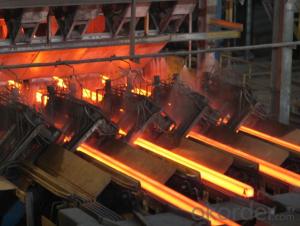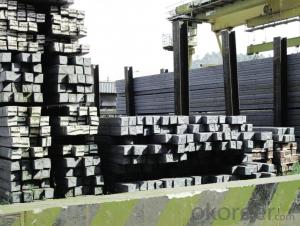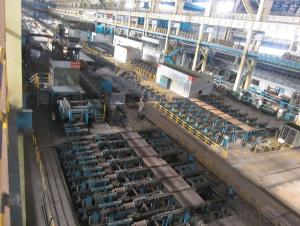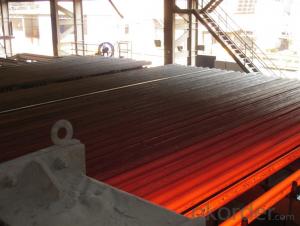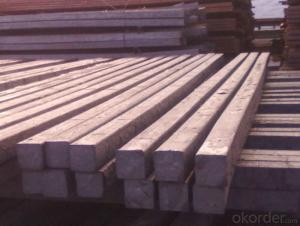Prime quality prepainted galvanized steel 670mm
- Loading Port:
- Tianjin
- Payment Terms:
- TT OR LC
- Min Order Qty:
- 100 m.t.
- Supply Capability:
- 10000 m.t./month
OKorder Service Pledge
OKorder Financial Service
You Might Also Like
Construction building material galvanized color prepainted cold
rolled steel coil
Prepainted steel sheet is coated with organic layer, which provides higher anti-corrosion property and
a longer lifespan than that of galvanized steel sheets.
The base metals for prepainted steel sheet consist of cold-rolled, HDG electro-galvanized and hot-dip
Alu-zinc coated. The finish coats of prepainted steel sheets can be classified into groups as follows:
polyester, silicon modified polyesters, polyvinylidene fluoride, high-durability polyester, etc
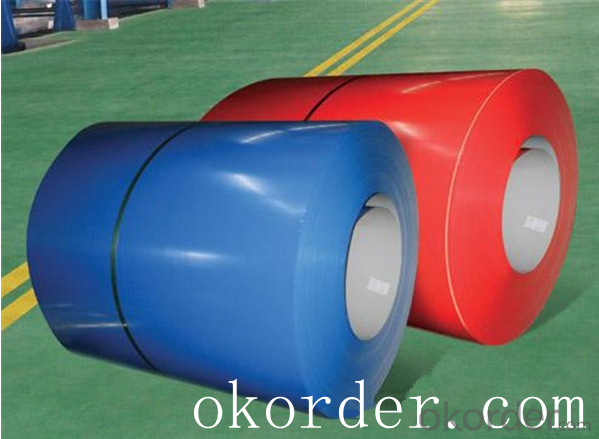
Standard and Grade :
Pre-paint galvanized steel coil | ||||
ASTM A755M-03 | EN10169:2006 | JISG 3312-2012 | ||
Commercial quality | CS | DX51D+Z | CGCC | |
Structure steel | SS GRADE 230 | S220GD+Z | CGC340 | |
SS GRADE 255 | S250GD+Z | CGC400 | ||
SS GRADE 275 | S280GD+Z | CGC440 | ||
SS GRADE 340 | S320GD+Z | CGC490 | ||
SS GRADE550 | S350GD+Z | CGC570 | ||
S550GD+Z | ||||
Application:
Outdoor | Roof, roof structure, surface sheet of balcony, frame of window, door of garage, rolled shutter door, booth, Persian blinds, cabana, etc |
Indoor | Door, isolater, frame of door, light steel structure of house, home electronic appliances, ect. |
Specifications
Commodity Name: Prepainted Galvanized Steel Coil
Standard: AISI, ASTM, DIN, GB, JIS
Grade: TDC52D+Z
Thickness 0.13-8.0mm
Width:600mm-1350mm
Zinc Coating:275g/m2
Polyester Coating Thickness:Top and Back coating thickness depend by Buyer Requirement.
Polyester Coating Type:2/2,1/2m,1/2.
Polyester Type: Polyester, silicone modified polyester, high durability polyester (HDP), polyvinylidene fluoride (PVDF)
Unit Roll Weight:5-20tons
Place of Origin Shanghai , China (Mainland)
Surface Treatment :Color Coated
Manufacture Progress:HRC-CRC-GALVANIZED-COLOR COATED
Application : Construction, electrical, transportation, steel plant, composite board plant, steel tile factory
Payment & Shipping Terms:T/T ,L/C, and FOB CHINA
Minimum Order Quantity: 25Tons
Packge Type: Moisture-proof paper inner,Steel outside,Bundle by steel rope.
Package in Container : Wood as a foot pad, wire rope reinforcement,PPGI steel coil tied together by steel rope.
- Q:How are steel billets used in the production of agricultural machinery?
- The production of agricultural machinery heavily relies on steel billets, which are vital in the manufacturing of different parts and components. These semi-finished metal products serve as the raw material, offering excellent mechanical properties, high strength, and corrosion resistance. To withstand the challenging conditions of agricultural operations, such as uneven terrains and exposure to moisture and chemicals, agricultural machinery like tractors, harvesters, and plows require sturdy and durable structures. Steel billets are the perfect material for constructing these robust structures. Initially, steel billets are melted and cast into a basic shape, usually rectangular or square. Then, they undergo further processing through techniques like forging, rolling, or extrusion to shape them into specific parts needed for agricultural machinery. These parts can include axles, gears, shafts, blades, and brackets. The utilization of steel billets in the production of agricultural machinery guarantees that the final products possess the required strength, durability, and reliability to perform efficiently in farm operations. Steel's inherent properties make it an ideal choice for ensuring the longevity and performance of these machines. Additionally, steel billets offer flexibility in terms of design and customization. Manufacturers can easily modify the shape, size, and dimensions of steel billets during the production process to meet the specific requirements of each machine. This adaptability allows for the creation of more efficient and specialized equipment to cater to various agricultural tasks. In conclusion, steel billets play a critical role in agricultural machinery production by providing the necessary strength and durability for farm operations. Their versatility, strength, and resistance to corrosion make them an ideal choice for manufacturing various components, ensuring the reliability and longevity of these machines in demanding agricultural environments.
- Q:What are the specifications for tool steel billets used in the automotive industry?
- Tool steel billets used in the automotive industry must meet specific criteria to ensure their suitability for various applications. These criteria are essential to guarantee the desired performance and durability of the tool steel in automotive manufacturing processes. One crucial criterion for tool steel billets used in the automotive industry is their chemical composition. The tool steel needs to have a precise composition of elements like carbon, chromium, vanadium, and molybdenum, among others. These elements contribute to the steel's hardness, wear resistance, and toughness, which are vital properties for automotive tooling. Furthermore, the tool steel billets must fall within a specific range of hardness. Hardness can be measured using scales such as Rockwell or Brinell, and the desired level of hardness depends on the intended application. Tools that require high wear resistance generally prefer higher hardness, while tools that require toughness and impact resistance may tolerate lower hardness. Additionally, the tool steel billets used in the automotive industry must display excellent dimensional stability. This means that the steel should undergo minimal dimensional changes during heat treatment and manufacturing processes, ensuring that the tools maintain their shape and accuracy over time. Another important criterion is the machinability of the tool steel. It should be easy to machine and shape into the desired tooling components without excessive tool wear or difficulty. Good machinability allows for efficient production and reduces costs associated with tooling. Moreover, the tool steel billets used in the automotive industry should exhibit good thermal conductivity. This property enables the effective dissipation of heat generated during manufacturing processes like forging or heat treatment. Good thermal conductivity helps prevent localized overheating and ensures uniform heat distribution throughout the tool, resulting in consistent performance. Lastly, the tool steel billets should be free from defects and impurities that could compromise the integrity and performance of the tool steel. These defects include cracks, voids, inclusions, or any other imperfections. Typically, quality control measures such as non-destructive testing are implemented to ensure that the billets meet the required standards. In conclusion, the specifications for tool steel billets used in the automotive industry encompass factors such as chemical composition, hardness, dimensional stability, machinability, thermal conductivity, and overall quality. These specifications guarantee that the tool steel meets the specific requirements of automotive tooling applications, providing durability, performance, and reliability in automotive manufacturing processes.
- Q:What are the main applications of steel billets in the aerospace industry?
- Steel billets are an essential component in the aerospace industry, finding numerous applications due to their exceptional strength, durability, and thermal properties. One of the main applications of steel billets in the aerospace industry is in the production of aircraft structural components. These billets are commonly used to manufacture critical parts such as landing gear, wing spars, fuselage frames, and engine mounts, providing the necessary strength and stability required for safe and efficient flight. Moreover, steel billets are also utilized in the aerospace industry for the production of engine components. Due to their high heat resistance and ability to withstand extreme temperatures, steel billets are used to manufacture turbine blades, shafts, and other critical parts within jet engines. These components must withstand intense heat and pressure, and steel billets offer the necessary properties to ensure reliable and efficient engine performance. Additionally, steel billets play a crucial role in the aerospace industry through their application in the production of fasteners and connectors. These components are vital for securely joining various parts of an aircraft, ensuring structural integrity and safety during flight. Steel billets are used to manufacture high-strength bolts, screws, and other fasteners, providing the necessary strength and reliability for aerospace applications. Furthermore, steel billets are often employed in the aerospace industry for the production of hydraulic and pneumatic systems. These systems are responsible for controlling the aircraft's movement, landing gear operation, and other crucial functions. Steel billets are used to manufacture hydraulic cylinders, valves, and tubes, offering the necessary strength and resistance to withstand high pressures and extreme conditions. In summary, the main applications of steel billets in the aerospace industry include aircraft structural components, engine parts, fasteners and connectors, as well as hydraulic and pneumatic systems. Their exceptional strength, durability, and thermal properties make steel billets indispensable for ensuring the safety, efficiency, and reliability of aerospace operations.
- Q:What are the different methods of steel billet surface cleaning?
- There are several methods of steel billet surface cleaning, including shot blasting, pickling, acid cleaning, mechanical cleaning, and electrochemical cleaning.
- Q:What are the main steel billet producing countries?
- The main steel billet producing countries are China, India, Russia, Japan, and the United States.
- Q:What are the different methods of surface inspection for steel billets?
- There are several methods of surface inspection for steel billets, including visual inspection, magnetic particle inspection, ultrasonic testing, eddy current testing, and dye penetrant testing. Visual inspection involves a thorough visual examination of the billet's surface to detect any visible defects or irregularities. Magnetic particle inspection uses magnetic fields and iron particles to identify surface cracks or defects. Ultrasonic testing uses high-frequency sound waves to detect internal and surface flaws in the billet. Eddy current testing uses electromagnetic induction to detect surface defects, while dye penetrant testing involves applying a colored dye to the surface and inspecting it for any indications of defects. These methods help ensure the quality and integrity of steel billets before further processing or use.
- Q:What is the role of steel billets in the manufacturing of construction excavators?
- Steel billets play a crucial role in the manufacturing of construction excavators. These billets, which are essentially semi-finished steel products in the form of a rectangular solid, serve as the primary raw material for constructing various components of excavators. One key aspect of steel billets is their high strength and durability. The construction industry demands materials that can withstand heavy loads, intense pressure, and harsh working conditions. Steel billets possess these characteristics, making them ideal for manufacturing excavators that are capable of withstanding the rigors of construction sites. During the manufacturing process, steel billets are heated and shaped into various components of the excavator. These components include the mainframe, booms, arms, and buckets – all of which require high-strength materials to ensure structural integrity and longevity. Additionally, steel billets allow for precise customization and fabrication. Manufacturers can mold and shape the billets into specific sizes and dimensions required for different parts of the excavator. This flexibility ensures that the components fit together seamlessly, enhancing the overall performance and functionality of the machine. Furthermore, steel billets provide excellent weldability. As excavators undergo constant stress and movements, welding is a crucial process for joining the various components. Steel billets enable strong and reliable welds, ensuring that the excavator remains structurally sound and capable of performing heavy-duty tasks. Overall, the role of steel billets in the manufacturing of construction excavators is indispensable. Their high strength, durability, customizability, and weldability make them the ideal raw material for constructing the robust and reliable machines that are required for the demanding nature of the construction industry.
- Q:What are the potential applications of steel billets in the agricultural aftermarket?
- The agricultural aftermarket offers a wide range of potential applications for steel billets. One important use in this industry is the manufacturing of agricultural machinery and equipment. Components such as plows, cultivators, seeders, and harvesting equipment can all be fabricated using steel billets. In the agricultural sector, machinery needs to be durable and robust to withstand the tough conditions of farming operations. Steel billets provide the necessary strength and toughness for tasks like tilling the soil or harvesting crops. Their high-strength properties make them perfect for handling heavy loads and rough terrain. Moreover, steel billets can be employed for constructing storage and handling structures. Steel buildings and structures are resistant to weathering, pests, and fire, making them ideal for storing agricultural products. By using steel billets for the main framework, these structures become durable and long-lasting. Another potential application of steel billets in the agricultural aftermarket is for fencing and livestock handling equipment. Steel fencing is commonly used to secure boundaries, contain livestock, and protect crops. By shaping and welding steel billets, strong and reliable fencing materials can be created. Furthermore, steel billets can be utilized in the production of irrigation systems and water management equipment. Efficient irrigation systems are essential for proper water distribution to crops. Steel billets can be used to fabricate critical components like pipes and valves, ensuring durability and longevity. In conclusion, steel billets have a wide range of potential applications in the agricultural aftermarket. From manufacturing machinery and equipment to constructing storage structures, fencing, and irrigation systems, steel billets offer the strength, durability, and reliability required in the demanding agricultural industry.
- Q:Can steel billets be used for making architectural structures?
- Yes, steel billets can be used for making architectural structures. Steel billets are commonly used as a raw material in the construction industry for various applications including the fabrication of beams, columns, and other structural components. The high strength and durability of steel make it an ideal choice for architectural structures, providing stability and structural integrity to buildings.
- Q:Are steel billets subject to any heat treatment processes?
- Indeed, heat treatment processes can be used on steel billets. Heat treatment is a regulated procedure that involves heating and cooling metals in order to modify their physical and mechanical properties. Steel billets, which are semi-finished steel products with a square or rectangular shape, can undergo different heat treatment processes depending on the desired properties for the final product. One commonly used heat treatment process for steel billets is annealing. Annealing consists of heating the billets to a specific temperature and gradually cooling them to relieve internal stresses and enhance their ductility and toughness. This process is typically employed to soften the steel and make it more malleable for subsequent manufacturing processes. Another heat treatment process for steel billets is quenching and tempering. Quenching involves rapidly cooling the heated steel billets in a liquid medium, such as oil or water, to achieve high hardness and strength. However, this process results in a hard but brittle material. To reduce the brittleness, the quenched billets are then tempered by reheating them to a lower temperature and slowly cooling them. Tempering improves the toughness and ductility of the steel while maintaining a certain level of hardness. Additional heat treatment processes that can be applied to steel billets include normalizing, which involves heating the steel above its critical temperature and then cooling it in still air to refine the grain structure, and stress relieving, which is performed to reduce residual stresses in the billets after extensive machining or welding. Overall, heat treatment processes can significantly improve the mechanical properties of steel billets, making them more suitable for various applications in industries such as automotive, construction, and manufacturing.
1. Manufacturer Overview |
|
|---|---|
| Location | |
| Year Established | |
| Annual Output Value | |
| Main Markets | |
| Company Certifications | |
2. Manufacturer Certificates |
|
|---|---|
| a) Certification Name | |
| Range | |
| Reference | |
| Validity Period | |
3. Manufacturer Capability |
|
|---|---|
| a)Trade Capacity | |
| Nearest Port | |
| Export Percentage | |
| No.of Employees in Trade Department | |
| Language Spoken: | |
| b)Factory Information | |
| Factory Size: | |
| No. of Production Lines | |
| Contract Manufacturing | |
| Product Price Range | |
Send your message to us
Prime quality prepainted galvanized steel 670mm
- Loading Port:
- Tianjin
- Payment Terms:
- TT OR LC
- Min Order Qty:
- 100 m.t.
- Supply Capability:
- 10000 m.t./month
OKorder Service Pledge
OKorder Financial Service
Similar products
New products
Hot products
Related keywords

